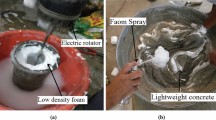Abstract
Building on weak soils is very challenging in engineering projects, especially highway and railway projects. To overcome these problems, especially in the construction of embankments and abutments, it is necessary to reduce the settlement of soil and increase the bearing capacity. This paper investigates the characteristics of expanded polystyrene (EPS) foam beads mixture as a lightweight construction material. EPS foam is characterized as a lightweight, economic and environmentally friendly material. Samples of different mixtures were prepared using EPS foam beads with sand, cement and water at different ratios. A series of rigorous tests were carried out to evaluate density, shear strength parameter, compressibility, and crushing strength of the prepared mixtures. The mixture of foam beads and sand was mixed in ratios 1:1, 1.5:1 and 1:2 by volume and mixed with cement content of 7%, 8%, 9% and 10% of sand weight using the optimum water content. From the results it was found that the best ratio between sand and foam beads by volume was 1:1, and high cement ratio of 10% formed lightweight mass with acceptable crushing strength, CBR and compressibility characteristics. The results proved that, the characteristics of the mixture are linearly proportional with cement content and curing time. Practically, the mixture can be used as a subgrade material to overcome the problems of weak soils especially in highway construction.













Similar content being viewed by others
References
Abdelrahman G, Elragi A (2006) Behavior improvement of footings on soft clay utilizing geofoam. in the 10th Arab structural engineering conference.Kuweit.
Stark T D, Guideline (2004) Recommended standard for geofoam applications in highway embankments. Vol. 529. 2004: Transportation Research Board.
Khalaj O, Azizian M, Moghaddas Tafreshi SN, Mašek B (2017) Laboratory investigation of buried pipes using geogrid and EPS geofoam block. IOP Conf Series: Earth and Environ Sci 95(2):022002. https://doi.org/10.1088/1755-1315/95/2/022002
Killingstad, A. (1972). Roads and Plastic (in Norwegian). Norsk plast. No. 10.
MA Bahr MF Tarek AA Hassan DM Hassaan 2019 Experimental Simulation for Load Reduction Techniques on Underground Utilities using Geofoam Int J: Academic Res Community Publication 2 4 323 331 https://doi.org/10.21625/archive.v2i4.375.
Tarek MF, Bahr MA, Hassan AA, Hassaan DM (2018) Behavior and Modeling of Some Underground Utilities Using Geofoam Technologies. Life Sci J 15(9):48–60. https://doi.org/10.7537/marslsj150918.06
Ashna K, Chandrakaran S (2017) Experimental study on stress-strain behaviour of EPS beads-sand mixture. International Conference on Geotechniques for infrastructure projects 27th & 28th February. 2017.
Miao L, Wang F, Han J (2013) Properties and applications of cement-treated sand-expanded polystyrene bead lightweight fill. J Mater Civ Eng 25(1):86–93. https://doi.org/10.1061/(ASCE)MT.1943-5533.0000556
Wang F, Miao L (2009) A proposed lightweight fill for embankments using cement-treated Yangzi River sand and expanded polystyrene (EPS) beads. Bull Eng Geol Env 68(4):5–17. https://doi.org/10.1007/s10064-009-0228-8
AS Reza I Shooshpasha 2015 Effect of cement stabilization on geotechnical properties of sandy soils Geomech Eng 81 17 31 https://doi.org/10.12989/GAE.2015.8.1.017
AASHTO M 145–91 (2008) Classification of soils and soil-aggregate mixtures for highway construction purposes. Washington, DC: AASHTO.
Soil and Rock (2017) Standard Practice for Classification of Soils for Engineering Purposes (Unified Soil Classification System) 1. 2017: ASTM International.
Portland Cement Assossiaton PCA (1995) Soil-cement construction handbook. EP003.10S, Portland Cement Association.
ASTM, D558 (2019) Standard test methods for moisture-density relations of soil-cement mixtures. ASTM D558, 1996. 5: pp 1–5.
ASTM D2216 (2019) Standard Test Methods for Laboratory Determination of Water (Moisture) Content of Soil and Rock by Mass, American Society for Testing and Materials International (ASTM): West Conshohocken. PA, USA
ASTM D2166 (2016) Standard Test Method for Unconfined Compressive Strength of Cohesive Soil. American Society for Testing and Materials International, 2016.
ASTM D1633 (2017) Standard Test Methods for Compressive Strength of Molded Soil-Cement Cylinders. American Society for Testing and Materials International, 2017.
ASTM D6528 (2007) Standard Test Method for Consolidated Undrain Direct Simple Shear Testing of Cohesive Soils. West Conshohocken, PA: ASTM International.
ASTM D1883 (2007) Standard Test Method for California Bearing Ratio (CBR) of Laboratory-Compacted Soils.
ASTM D2435 (2011) Standard test methods for one-dimensional consolidation properties of soils using incremental loading.
A Linares-Unamunzaga 2018 New procedure for compacting prismatic specimens of cement-treated base materials Appl Sci 8 6 970 https://doi.org/10.3390/app8060970
SI Haralambos 2009 Compressive strength of soil improved with cement In Contemporary topics in ground modification, problem soils, and geo-support 289–296 https://doi.org/10.1061/41023(337)37.
Hassaan DM, Tarek MF, Bahr MA (2013) Utilization of Lightweight Materials to Improving the Loading Conditions in Geotechnical, MSc dissertation. Al-Azhar University, Cairo, Egypt, Civil Eng Dep.
Acknowledgements
The authors are very grateful to the Civil Engineering Department, Higher Technological Institute, 10th of Ramadan City, Egypt and to the School of Energy, Construction and Environment, Coventry University, for use of their laboratories and resources.
Author information
Authors and Affiliations
Contributions
Conceptualization: DH and MS and AS, Formal analysis: DH and MS, Investigation: DH and MS, Methodology: DH, MS, Writing – review & editing: DH, MS and AS.
Corresponding author
Additional information
Publisher's Note
Springer Nature remains neutral with regard to jurisdictional claims in published maps and institutional affiliations.
Rights and permissions
About this article
Cite this article
Hassan, D., Saidani, M. & Shibani, A. Behaviour of a Foam Mixture as a Lightweight Construction Material. Int. J. of Geosynth. and Ground Eng. 7, 51 (2021). https://doi.org/10.1007/s40891-021-00296-5
Received:
Accepted:
Published:
DOI: https://doi.org/10.1007/s40891-021-00296-5




